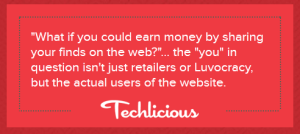 How would you run your business if you could rent shop fronts for free, paid nothing for delivery, and had products that cost nothing to make? Let me introduce you to Web 2.0 selling and leveraging the long tail of sales.
How would you run your business if you could rent shop fronts for free, paid nothing for delivery, and had products that cost nothing to make? Let me introduce you to Web 2.0 selling and leveraging the long tail of sales.
This strategy for success was proposed by O’Reilly as one of the key patterns for Web 2.0. The secret is to use the internet to remove the physical costs of selling, so the amount of inventory and range of products is unlimited and the market is global. This means business’ can avoid chasing the popular high-volume sales at the front of the sales curve, and capitalise on the niche products and the longer selling window of the ‘long tail’ – and Amazon is a classic example. The Internet is perfect for capitalising on the benefits of leveraging the long tail, as O’Reilly explains:
Small sites make up the bulk of the internet’s content; narrow niches make up the bulk of internet’s the possible applications. Therefore, leverage customer-self service and algorithmic data management to reach out to the entire web, to the edges and not just the center, to the long tail and not just the head.
A classic example of the virtual shop and unique product sales is iTunes and ringtones which cost nothing to sell or deliver and very little to make. The idea of selling ringtones was seen as ‘the next big thing’ back in 2001 and although they faced some challenges they are still making money in the long tail of sales – even though you can create your own!
The benefits that the internet offer to leverage the long tail are unique:
> Producers can reach a wider audience with new micro-markets built off small sites
> Customers have a wider range of products not just the popular but also the unusual and niche
> Business and customers profit from reduced costs of online commence and internet delivery
So how do you get some share of the money? One recent example is a spin-off from the Pinterest concept, by a new startup called Luvocracy. Their concept is to ‘find people you trust and shop what they luv’…where social media meets sales in the new marketplace!
Luvocracy is a great example of O’Reilly’s leveraging the long tail pattern and meets most of the recommended best practices:
* Use the three forces of the long tail to make the tail longer with an unlimited supply of goods highlighting only those for sale, makes the tail fatter by growing the customer size with the social networking, and drives supply and demand by the recommendations of users and the easy purchase options.
* Use both algorithmic data management behind the scenes to bring product sales to the attention of users and uses an architecture of participation to match supply and demand through their users and their followers networking their finds and purchases which leads to curated shopping – where you buy what others recommend.
* Use low-cost strategies to allow both business’ and users to manage their own accounts and use the low-cost advantages of an online site to reduce business overheads.
Luvocracy seems to have successfully harnessed a lot of the integrated strategies identified by research (Lee, 2010) where retention and co-creation, product reviews, cross-marketing and word-of-mouth all rate highly in the new marketplace.
Although this site is only in beta, there has been some push back on possible issues:
* Lack of attribution to the original content owner is causing some copyright concerns,
* Offers for others to make copies of the handmade originals when they are out of stock seems to breach the original owners rights,
* Opportunities for both the blogger and the product maker to make money is upsetting product makers and opening a new discussion around marketing channels.
So, do you luv it, or not? Let me know what you think.
___________________
More information about the Long Tail:
Hervas-Drane, Andres, Word of Mouth and Sales Concentration (February 13, 2013). NET Institute Working Paper No. 07-41. Available at SSRN: http://ssrn.com/abstract=1025123 or http://dx.doi.org/10.2139/ssrn.1025123
Lee, T. (2010). Head or tail? an integrative analysis of customer value and product portfolio. International Journal of Business and Management, 5(12), 51-61. Retrieved from http://search.proquest.com/docview/821639654?accountid=13380



